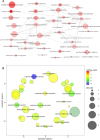Genome-Wide Identification of Differentially Expressed Genes Associated with the High Yielding of Oleoresin in Secondary Xylem of Masson Pine (Pinus massoniana Lamb) by Transcriptomic Analysis
- PMID: 26167875
- PMCID: PMC4500461
- DOI: 10.1371/journal.pone.0132624
Genome-Wide Identification of Differentially Expressed Genes Associated with the High Yielding of Oleoresin in Secondary Xylem of Masson Pine (Pinus massoniana Lamb) by Transcriptomic Analysis
Abstract
Masson pine is an important timber and resource for oleoresin in South China. Increasing yield of oleoresin in stems can raise economic benefits and enhance the resistance to bark beetles. However, the genetic mechanisms for regulating the yield of oleoresin were still unknown. Here, high-throughput sequencing technology was used to investigate the transcriptome and compare the gene expression profiles of high and low oleoresin-yielding genotypes. A total of 40,690,540 reads were obtained and assembled into 137,499 transcripts from the secondary xylem tissues. We identified 84,842 candidate unigenes based on sequence annotation using various databases and 96 unigenes were candidates for terpenoid backbone biosynthesis in pine. By comparing the expression profiles of high and low oleoresin-yielding genotypes, 649 differentially expressed genes (DEGs) were identified. GO enrichment analysis of DEGs revealed that multiple pathways were related to high yield of oleoresin. Nine candidate genes were validated by QPCR analysis. Among them, the candidate genes encoding geranylgeranyl diphosphate synthase (GGPS) and (-)-alpha/beta-pinene synthase were up-regulated in the high oleoresin-yielding genotype, while tricyclene synthase revealed lower expression level, which was in good agreement with the GC/MS result. In addition, DEG encoding ABC transporters, pathogenesis-related proteins (PR5 and PR9), phosphomethylpyrimidine synthase, non-specific lipid-transfer protein-like protein and ethylene responsive transcription factors (ERFs) were also confirmed to be critical for the biosynthesis of oleoresin. The next-generation sequencing strategy used in this study has proven to be a powerful means for analyzing transcriptome variation related to the yield of oleoresin in masson pine. The candidate genes encoding GGPS, (-)-alpha/beta-pinene, tricyclene synthase, ABC transporters, non-specific lipid-transfer protein-like protein, phosphomethylpyrimidine synthase, ERFs and pathogen responses may play important roles in regulating the yield of oleoresin. These DEGs are worthy of special attention in future studies.
Conflict of interest statement
Figures




References
-
- Trapp S, Croteau R (2001) Defensive resin biosynthesis in conifers. Annu Rev Plant Physiol Plant Mol Biol 52: 689–724. - PubMed
-
- Coppen JJW, Hone GA (1995) Gum Naval Stores: Turpentine and rosin from pine resin Non-wood forest products 2. Natural Resources Institute, FAO, Rome: p62.
-
- Lee HJ, Ravn MM, Coates RM (2001) Synthesis and characterization of abietadiene, levopimaradiene, palustradiene, and neoabietadiene: hydrocarbon precursors of the abietane diterpene resin acids. Tetrahedron 57: 6155–6177.
-
- Kelkar VM, Geils BW, Becker DR, Overby ST, Neary DG (2006) How to recover more value from small pine trees: essential oils and resins. Biomass Bioenerg 30: 316–320.
-
- da Silva Rodrigues-Correa KC, Lima JC, Fett-Neto AG (2013) Oleoresins from pine: production and industrial uses Natural Products. Springer.Germany: Berlin: pp 4037–4060
Publication types
MeSH terms
Substances
LinkOut - more resources
Full Text Sources
Other Literature Sources
Miscellaneous

